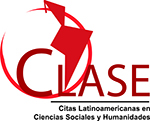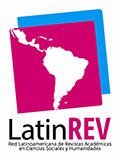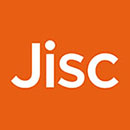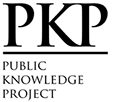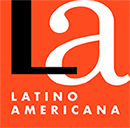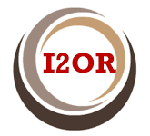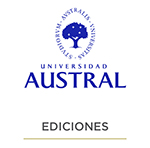Envíos
Directrices para autores/as
Las fechas de recepción de los trabajos son las siguientes:
Para el número de junio: hasta el 15 de abril.
Para el número de diciembre: hasta el 15 de octubre.
Los trabajos deberán ajustarse a las directrices que a continuación se detallan sin excepción. Aquellos que no se ajusten a las recomendaciones editoriales serán devueltos para su adecuación antes de ser considerados por el Consejo de Redacción para su revisión.
Los originales deberán estar concluidos cuando se entreguen para publicar; no se podrán introducir modificaciones que no estén debidamente justificadas y autorizadas por el Consejo de Redacción. Se recomienda a los autores la lectura y revisión crítica del texto, en particular su redacción, sintaxis y ortografía en nombres, siglas y datos bibliográficos.
Instrucciones generales
Se aceptan trabajos en versión electrónica en formato Microsoft Word (no se aceptarán archivos en formato PDF).
Los artículos deben ser originales e inéditos y escritos en español, portugués o inglés. En este último caso, serán admitidos solo si el objeto de análisis tiene relación con Iberoamérica o si son estudios de derecho comparado que incluyen uno o más países iberoamericanos. En ellos deben consignarse: el título del trabajo, de 8 a 10 palabras clave y un resumen de entre 200 y 300 palabras, todo en español, portugués e inglés. Deberán enviarse sin consignar el nombre o la firma del autor o autores, anonimizando el manuscrito de modo tal que se preserve su identidad en todo el proceso de revisión.
Asimismo, deberán adjuntarse en forma separada los datos personales del autor o autores, pertenencia institucional, un breve currículum que no exceda las diez líneas y dirección de correo electrónico.
Los trabajos se recibirán por medio del sistema Open Journal System, al cual se accede a través de este portal. El envío debe contener todos los requisitos que solicita el sistema.
Para asegurar la integridad de las evaluaciones anónimas por pares de los envíos, se hará todo lo posible para impedir que los autores conozcan la identidad de los revisores y viceversa. Para ello, se deben comprobar que se han seguido los siguientes pasos relacionados con el texto y con las propiedades del archivo:
* Los autores del documento han borrado sus nombres del texto y han evitado autorreferenciarse.
* En el caso de los documentos de Microsoft Office, también deberá quitarse la identificación del autor de las propiedades del archivo haciendo clic en las opciones que se indican a continuación. Empezar con Archivo en el menú principal de la aplicación de Microsoft: Archivo > Guardar como > Herramientas (u Opciones en Mac) > Seguridad > Eliminar información personal de las propiedades del archivo al guardar > Guardar.
Declaración de roles de autoría
Al final de cada artículo se deberá incluir el tipo de responsabilidad que ha tenido cada autor en la elaboración del trabajo. Para ello, deberá utilizar la taxonomía de redes de colaboración académica (CRediT), que tiene el objetivo de proporcionar crédito a todos los roles que intervienen en un proceso de investigación y garantizar que estos sean visualizados y reconocidos durante la comunicación de los resultados. La definición de catorce categorías permite, además, identificar estos roles de autoría como objetos de recuperación, por lo que serán sensibles a su clasificación y su posterior reutilización en el marco de otros procesos investigativos.
En http://hdlab.space/taxonomia/?q=CRediT se encuentran todos los roles.
Ejemplos
* Un autor
El autor declara haber desempeñado todos los roles de autoría del presente artículo.
* Dos o más autores
López, J: conceptualización, metodología; Suárez, M.: curación de datos, escritura, borrador original;
Gómez, A.: conceptualización, visualización, escritura, revisión y edición; García, D.: escritura, revisión y edición.
Todos los autores contribuyeron en la concepción de la idea, diseño del estudio, el proceso de investigación, la
recolección, análisis e interpretación de los datos y en la redacción del artículo.
Declaración de conflicto de interés
Al final del trabajo, se deberá consignar que el autor no posee conflicto de interés alguno.
Obligatoriedad de depósito de datos respaldatorios
Los autores nacionales deberán tener en cuenta que, conforme la Ley 26899 de “Creación de Repositorios Digitales Institucionales de Acceso Abierto, Propios o Compartidos”, en el caso de que sus resultados de investigación publicados en el artículo hayan sido financiados o cofinanciados con fondos públicos, están obligados a publicar sus trabajos y datos primarios en repositorios institucionales, propios o compartidos. La cita del conjunto de datos depositados debe aparecer en la bibliografía del trabajo.
Contribuciones
Artículos
Se publicarán artículos de investigación originales e inéditos relacionados con el área del derecho de la propiedad intelectual e industrial, los cuales deben ofrecer aportes significativos al desarrollo de esta temática, proporcionando criterios de análisis e interpretación del derecho que resulten válidos y útiles para los lectores.
Se aceptarán artículos que traten los siguientes temas:
- Derecho de autor y conexos.
- Derecho de marcas y patentes, diseños, variedades vegetales y otros derechos de propiedad industrial.
- Transferencia y protección de información confidencial y know-how.
- Defensa de la competencia y competencia desleal en relación con la propiedad intelectual.
- Contratos vinculados a la propiedad industrial e intelectual.
Los artículos deberán estar escritos para publicarlos dentro de alguna de las cuatro secciones de la RIPI:
a) Doctrina
b) Estudios
c) Jurisprudencia comentada
d) Legislación comentada
La sección de Doctrina presenta artículos de autores iberoamericanos con un enfoque de la ciencia del derecho. Los artículos se refieren a temas novedosos o, al menos, con un análisis desde una nueva perspectiva. También se admiten traducciones de trabajos originales publicados inicialmente en idiomas distintos al castellano, portugués o inglés.
Extensión: de 20 a 40 páginas, es decir, entre 9000 y 18000 palabras.
A modo de orientación, se sugiere que los artículos sigan la siguiente estructura:
- Introducción
- Desarrollo
- Conclusiones
- Bibliografía citada
- Legislación y jurisprudencia citadas
- Anexos y/o apéndices
La sección Estudios presenta informes, de cierta extensión, elaborados a partir de consultorías, estudios, informes estadísticos o trabajos de tesis, no necesariamente jurídicos. No se requiere que sean inéditos y pueden ser el resultado de trabajos requeridos por organismos internacionales, organismos públicos o centros de investigación. Puede tratarse de trabajos interdisciplinarios. En caso de ser necesario, deberán adaptarse para seguir las mismas reglas de citación requeridas en la sección Doctrina.
Extensión: no hay límite de extensión.
También deberán incluir: título, 8 a 10 palabras clave y resumen, todo en español, portugués e inglés; bibliografía utilizada; anexos y/o apéndices.
La sección de Jurisprudencia comentada cuenta con el análisis de especialistas del Derecho de la Propiedad Intelectual, que identifican las sentencias más relevantes de los tribunales nacionales e internacionales.
Extensión: de 4 a 20 páginas, es decir, entre 1800 y 9000 palabras.
La sección de Legislación comentada presenta las novedades normativas más relevantes de la región e internacionales.
Extensión: de 4 a 20 páginas, es decir, entre 1800 y 9000 palabras.
Estilo
Los trabajos enviados deberán seguir el estilo de la RIPI, que a continuación se detalla:
* Formato
Tamaño A4 con márgenes de 2,5 cm en cada extremo.
* Tipografía
Título: Times New Roman, negrita, cuerpo 14 puntos, interlineado 1,5. Texto: Times New Roman, cuerpo 12 puntos, interlineado 1,5.
Citas textuales de más de 40 palabras: Times New Roman, cuerpo 10 puntos, interlineado a 1,5.
Notas al pie: Times New Roman, cuerpo 10 puntos, interlineado a 1,5.
Subtítulos (en todas sus jerarquías): Times New Roman, negrita, cuerpo 12 puntos, interlineado a 1,5.
Estilo de numeración: correlativa en números arábigos (no utilizar números romanos).
* Alineación
Todo el texto y los títulos deben estar alineados a la izquierda, sin utilizar sangrías ni tabulaciones. No dejar espacios entre párrafos.
Las citas textuales de más de 40 palabras deben colocarse en párrafo aparte con una sangría de 1,5 para todo el párrafo.
* Se deben respetar los signos diacríticos propios de cada idioma (diéresis, acentos ortográficos, etc.), incluso en las mayúsculas. Las frases no deben comenzarse con abreviaciones ni números expresados en cifras.
* Todas las imágenes (fotos, tablas, ilustraciones, gráficos, etc.) deben citarse en el texto, por ejemplo: (Figura 1), para fotos, gráficos e ilustraciones; (Tabla 4) para tablas.
* Los fragmentos, frases o palabras que se transcriban en idioma extranjero deben ponerse en letra cursiva. Se exceptúan los nombres geográficos, los nombres de entidades, organismos, instituciones, corporaciones, etc.; los nombres de acuerdos, pactos o tratados, etcétera.
* Las llamadas de las notas al pie se indican en números arábigos consecutivos en superíndice y, cuando corresponda, luego de los signos de puntuación, por ejemplo: ,3
* En el cuerpo del trabajo no deben emplearse ni subrayados ni negritas. En caso de que sea necesario enfatizar una palabra, se hará entre comillas dobles.
* Abreviaciones
Se deja un espacio después de todo signo de puntuación: A. L. Jiménez y no A.L. Jiménez.
Los acrónimos deben escribirse totalmente con mayúsculas y sin puntuación, por ejemplo: UBA (por Universidad de Buenos Aires).
* Tablas, cuadros y gráficos
Pueden ser realizados con Excel o Power Point, según sea necesario, y ser pegados en el archivo Word como imagen. Además, deberá enviarse el archivo original donde se realizaron para poder corregirlos, si fuera necesario.
* Ilustraciones, mapas, fotografías, dibujos
Deberán ser pegados en el archivo Word y además enviados por separado en alguno de los siguientes formatos: JPG, TIF, PNG, AI, PS en alta resolución.
Citas y bibliografía
Para las citas y las referencias bibliográficas, la RJA sigue el estilo de las normas APA (American Psychological Association) 7a edición. Se recomienda seguir los siguientes ejemplos:
Citas
Las referencias a autores deben estar insertas en el texto y no en nota al pie: (Bianchi, 2005).
Si la cita tiene dos autores, se colocan los dos apellidos: (Marcus y Perry, 1985).
Si la cita tiene tres o más autores, se coloca el primer apellido y "et al.": (Álvarez et al., 2015).
Si la cita es textual y tiene menos de 40 palabras, se coloca entre comillas sin cursiva:
Las opiniones consultivas cumplen, pues, una función trascendente en el desarrollo de los principios de derecho
internacional de los derechos humanos, ya que, como señala Buergenthal (1985), “parecen prestarse más
fácilmente que los casos contenciosos a la articulación de principios legales generales” (p. 18).
Si tiene 40 palabras o más, se coloca en párrafo aparte con una sangría de 1,5, sin comillas ni cursiva:
Luego de arrogarse la atribución de no aplicar las leyes anticonstitucionales, la Corte Suprema la ejercitó con tanta
moderación que transcurrió más de medio siglo sin que otra ley del Congreso fuera rechazada por el tribunal. Ello
aconteció en 1857, en otro caso famoso, el de Dred Scott v. Sanford. (Bidegain, 1994, p. 127)
Si una cita textual extraída de un trabajo publicado en formato digital no tiene identificado el número de página, se debe identificar el número de párrafo:
Nótese que un gobierno podría –en una ley procesal, que puede sancionar por mayoría simple– agrupar
todos los jueces que le molestan y asignarlos a una sala a la que le atribuya competencia marginal, y
dejar jueces más favorables en una sala temática a la que le asigne centralidad y mayor chance de
intervención. (Arballo, 2014, párr. 9)
Las citas textuales en idioma extranjero se ponen entre comillas y sin cursiva.
Se recomienda a los autores evitar la autorreferencialidad, es decir, citarse a sí mismo en el cuerpo del texto.
Bibliografía
Se ordena en orden alfabético de autores y en orden cronológico cuando se citen varios trabajos del mismo autor. Si hubiera trabajos del mismo autor con la misma fecha, se deben identificar agregando una letra minúscula, por ejemplo: (2006a), (2006b).
Si hubiera trabajos que no tienen especificada la fecha, se coloca: (s.f.).
Si hubiera dos o más trabajos de un mismo que no tienen especificada la fecha, se coloca: (s.f.-a), (s.f.-b).
Se recomienda seguir el siguiente estilo:
* Libro impreso
Apellido, N. (año). Título del trabajo. Editorial.
* Libro en línea
Apellido, N. y Apellido, N. (año). Título del libro. Editorial. https://doi.org.
Apellido, N. y Apellido, N. (año). Título del libro. Editorial. https://www.url.com.
* Libro con editor, coordinador, director
Apellido, N. (Ed.) (año). Título del trabajo. Editorial.
Apellido, N. y Apellido, N. (Coords.) (año). Título del trabajo. Editorial.
* Capítulo de libro
Apellido, N. (año). Título del capítulo o entrada. En Apellido, N. (Ed.), Título del libro (pp. inicio-fin del capítulo).
Editorial.
Apellido, N. (año). Título del capítulo o entrada. En Apellido, N. (Ed.), Título del libro (xx ed., Vol. xx, pp. inicio-fin
del capítulo). Editorial.
* Artículo en revista
Apellido, N. (año). Título del artículo. Nombre de la revista, volumen(número), número de las páginas xx-xx.
Apellido, N. (año). Título del artículo. Nombre de la revista, volumen(número), número de las páginas xx-xx.
https://doi.org.
Apellido, N. (año). Título del artículo. Nombre de la revista, volumen(número), número de las páginas xx-xx.
https://www.url.com.
* Trabajos sin identificación del autor
Título del trabajo. (año). Fuente.
* Artículo en periódico
Apellido, N. (día, mes, año). Título del artículo. Nombre del periódico, número de página.
Apellido, N. (día, mes, año). Título del artículo. Nombre del periódico. https://www.url.com.
* Artículo en periódico sin identificación del autor
Título del artículo. (día, mes, año). Nombre del periódico, número de página.
Título del artículo. (día, mes, año). Nombre del periódico. https://www.url.com.
* Diccionarios o enciclopedias
Apellido Autor o Editor, N. (Ed., cuando es editor). (Año). Nombre del diccionario o enciclopedia (xx ed., Vol. xx).
Editorial.
* Tesis y doctorados
Apellido, N. (año). Título de la tesis (Tesis de pregrado, maestría o doctoral). Nombre de la institución, Ciudad.
Apellido, N. (año). Título de la tesis (Tesis de pregrado, maestría o doctoral). Nombre de la institución, Ciudad.
https://www.url.com.
* Referencia a páginas webs
Apellido, N. (año). Nombre de la página. https://www.url.com.
Apellido, N. (año). Título del artículo. Nombre de la página. https://www.url.com.
Nombre de la página o institución. (año). Título del artículo. https://www.url.com.
* Referencia a páginas webs sin fecha
Apellido, N. (s.f.). Nombre de la página. https://www.url.com.
Apellido, N. (s.f.). Título del artículo. Nombre de la página. https://www.url.com.
Nombre de la página o institución. (s.f.). Título del artículo. https://www.url.com.
* Ponencias y conferencias
Apellido, N. (año). Título de la ponencia o conferencia. Nombre de las jornadas o simposio donde se presentó.
Ciudad, País, fecha.
* Informes de instituciones
Nombre completo de la institución. (año). Título del informe. Editorial.
Nombre completo de la institución. (año). Título del informe. https://www.url.com.
* Datos respaldatorios de investigación
Apellido, N. (año). Título del conjunto de datos [conjunto de datos]. URL del repositorio o DOI.
Cool, H. E. M. y Bell, M. (2011). Excavations at St Peter’s Church, Barton-upon-Humber [conjunto de datos].
https://doi.org/10.5284/1000389.
Citas de legislación y jurisprudencia
Las referencias a la legislación y jurisprudencia citadas se colocarán en nota al pie (cuando sean citadas en el texto) o luego de la bibliografía, de acuerdo a la siguiente clasificación:
Legislación
* Normas internacionales (pactos, convenios, declaraciones)
* Normativa comunitaria
* Leyes ratificatorias de tratados internacionales
* Constituciones
* Códigos
* Leyes
* Decretos
* Resoluciones
* Disposiciones
Estilo a seguir:
Constitución de la Nación Argentina.
Constitución de la Nación Argentina, artículo 75, inciso 2 (o 75.2.).
Leyes
Ley 11723.
Ley 11723 de Propiedad Intelectual, BO 30/09/1933.
Ley 11723 de Propiedad Intelectual, BO 30/09/1933, artículo 5.
Decretos
Decreto 245/2002.
Decreto 245/2002, BO 28/11/2002, artículo 5.
Resoluciones
Resolución 2030/2015.
Resolución 2030/2015, BO 12/06/2015, artículo 1.
Disposiciones
Disposición 306/2015.
Disposición 306/2015, BO 28/05/2015.
Jurisprudencia
* Corte Suprema (nacional, federal, provincial, internacional)
* Tribunales internacionales
* Tribunales del sistema interamericano
Estilo a seguir:
Corte Suprema de Justicia de la Nación, Fernández Arias c/Poggio, 19/09/1960, Fallos: 247:646.
Suprema Corte de Justicia de Buenos Aires, Vasena Marengo, José Francisco y otra c/Rodríguez, Jorge Mario
y otra, 28/09/2004.
Cámara Federal de Casación Penal: Di Plácido, Jorge Alberto, 22/5/2014, [FBB/7963/2013/CFC1, Registro 864/14].
Suprema Corte de los Estados Unidos, Wood v. Milyard, 566 U.S. 463 (2012).
Suprema Corte de Carolina del Norte, Bayard v. Singleton, 1 N.C. 5 (1787).
Sentencia del Tribunal Constitucional, 83/2016, 28 de abril. [España]
Corte Interamericana de Derechos Humanos, Caso Almonacid Arellano y otros vs. Chile, Excepciones Preliminares,
Fondo, Reparaciones y Costas, 26/09/2006, Serie C, N° 154.
Fallos: 329:2316
Lista de comprobación para la preparación de envíos
Todos los envíos deben cumplir los siguientes requisitos.
- El autor manifiesta que el manuscrito enviado es de su autoría, original e inédito y declara no tener conflicto de interés alguno.
- El envío no ha sido publicado previamente ni se ha sometido a consideración por ninguna otra revista (o se ha proporcionado una explicación al respecto en los Comentarios al editor/a).
- El archivo de envío está en formato Microsoft Word. Las imágenes están en formato TIF, PNG, AI, PS en alta resolución. Las tablas y gráficos están en formato Microsoft Excel.
- Siempre que sea posible, se proporcionan direcciones URL para las referencias.
- El texto está escrito en Times New Roman cuerpo 12, con interlineado 1,5; todas las ilustraciones, figuras y tablas se encuentran colocadas en los lugares del texto apropiados y se adjuntan también en archivo aparte.
- El texto se adhiere a los requisitos estilísticos y bibliográficos resumidos en las Directrices del autor/a, que aparecen en Acerca de la revista.
- El título, el resumen y las palabras clave están en español, portugués e inglés.
- El autor ha leído atentamente la información contenida en esta página acerca de los términos y condiciones de la Licencia de Uso de los Derechos de Autor y la adhesión o aceptación automática que genera el envío de los trabajos para publicar con el alta de usuario y contraseña en el sistema.
- El autor ha borrado su nombre del texto y ha evitado autorreferenciarse.
- El autor ha eliminado la identificación personal de las propiedades del archivo de Microsoft Office.
- El autor declara que, en el caso de que sus resultados de investigación publicados en el artículo hayan sido financiados o cofinanciados con fondos públicos, ha depositado sus trabajos y datos primarios en repositorios institucionales para así cumplimentar lo requerido en la Ley 26899.
Aviso de derechos de autor/a
Esta licencia permite copiar, distribuir, exhibir y representar la obra siempre y cuando se reconozca la autoría y se cite la obra de la forma adecuada. No se permite el uso comercial de la obra original ni la generación de obras derivadas.
Los autores garantizan a la Revista Iberoamericana de la Propiedad Intelectual el derecho de ser la primera publicación del trabajo.
Declaración de privacidad
Los nombres y las direcciones de correo electrónico introducidos en esta revista se usarán exclusivamente para los fines establecidos en ella y no se proporcionarán a terceros o para su uso con otros fines.









